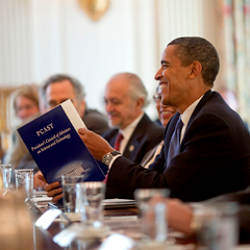
Is computer science rightly part of public education? How much does the U.S. government spend on basic networking and IT research? Should industry provide that funding instead? How important is supercomputing?
These are some of the questions addressed by a 148-page report released by the President’s Council of Advisors on Science and Technology (PCAST) last December. Titled Designing a Digital Future: Federally Funded Research and Development in Networking and Information Technology, the report looked at U.S. investments in the cross-agency Networking and Information Technology Research and Development (NI-TRD) program, currently totaling approximately $4.3 billion per year.
Among other points, the council called for affirmation of computer science as a part of education in science, technology, engineering, and math; increased investment in the areas of privacy, human-computer interaction, massive data stores, and physical instrumentation such as sensors and robotics; long-term, multi-agency NIT initiatives for health, energy, transportation, and security; better coordination among agencies by the Office of Science and Technology Policy and the National Science and Technology Council; and a standing committee to provide ongoing strategic perspectives.
The report also warned against single-minded performance metrics when evaluating high-performance computing (HPC) projects—a subject made timely by Top500’s most-recent ranking of the world’s fastest supercomputers, which appeared five weeks before PCAST released its report. The Chinese-built Tianhe-1A supercomputer topped that list, bumping U.S.-made computers from the lead spot for the first time in six years. The report stated that “comparative rankings of the world’s fastest supercomputers” are “relevant to only some of our national priorities,” and said that they shouldn’t ” ‘crowd out’ the fundamental research in computer science and engineering that will be required to develop truly transformational next-generation HPC systems.”
PCAST called for an increase of $1 billion in funding for “new, potentially transformative NIT research” and recommended more specific accounting to separate basic NIT research from infrastructure costs. The report’s Working Group Co-chair and University of Washington Professor Ed Lazowska was quick to point out that the money was used in ways that are “appropriate and important”—for example, large-scale genome databases—although not “pushing the forefront of NIT.”
Independent technology reviews of this sort were mandated under the High-Performance Computing Act of 1991. The previous review, published in 2007, “found many of the same issues” according to that report’s co-chair, Microsoft Corporate Vice President Daniel Reed. But he did note some changes of focus, such as the marked increase in data. “We’ve gone from a world where data was rare and precious to where we’re drowning in it,” Reed says.
The report also documented NIT’s importance to U.S. competitiveness—and the payback for NIT investment.
An example of high payback was given at the report’s public release by Akamai founder Tom Leighton. He related a story of U.S. Defense Advanced Research Projects Agency funding he received in the 1990s to study “highly mathematical and highly theoretical subjects … the living example of high-risk research.” When the research was finished, Internet companies weren’t interested in the results—even for free.
“So we started a company called Akamai Technologies,” Leighton says. “We [now] carry over a third of Web traffic … and are probably paying over a $100 million in taxes this year. But it wasn’t the kind of research that companies fund.”




Join the Discussion (0)
Become a Member or Sign In to Post a Comment